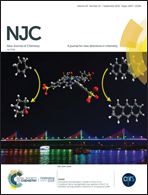Structural and electrochemical behavior of a NiMnO3/Mn2O3 nanocomposite as an anode for high rate and long cycle lithium ion batteries
Abstract
In this work, a pre-designed NiMnO3/Mn2O3 nanocomposite is synthesized via a facile urea-assisted auto-combustion synthesis method followed by annealing at 600 °C for 5 h in air as an anode material for lithium-ion batteries. Powder X-ray diffraction analysis confirmed the formation of the NiMnO3/Mn2O3 nanocomposite. Using Rietveld refinement analysis, the phase fraction of NiMnO3 and Mn2O3 phases was found to be ∼89% and ∼11%, respectively. It is believed that the interaction between NiMnO3 and Mn2O3 nanoparticles enhanced the charge transfer efficiency, which is favorable for an excellent electrochemical performance of the nanocomposite electrode. Electrochemical properties are evaluated via cyclic voltammetry and galvanostatic cycling studies. Benefiting from the high structural integrity and synergistic effect between NiMnO3 and Mn2O3, this nanocomposite exhibits a high reversible capacity (854.4 mA h g−1 at 1.0C for 200 cycles and 444.1 mA h g−1 at 2.0C for 500 cycles), excellent cycling stability (98% capacity retention after 200 cycles) and good rate capability (811.2 mA h g−1 at 2.0C). The values are much higher than the theoretical capacity of graphite (372 mA h g−1).



 Please wait while we load your content...
Please wait while we load your content...